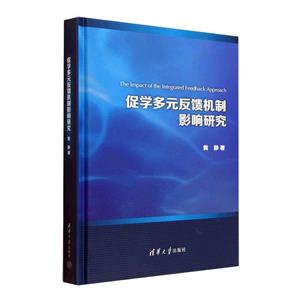扫一扫
关注中图网
官方微博
¥76.5(6.5折)?
预估到手价是按参与促销活动、以最优惠的购买方案计算出的价格(不含优惠券部分),仅供参考,未必等同于实际到手价。
促销活动:
本类五星书更多>
-
>
鲍勃·迪伦诗歌集:1961-2012:典藏版
-
>
双城记-英文版
-
>
四级词汇词根+联想记忆法:乱序版
-
>
The secret garden
-
>
哈克贝利.费恩历险记/床头灯英语.2000词读物(英汉对照)
-
>
10000德语分类词汇联想记忆
-
>
英语词汇全书
促学多元反馈机制影响研究 版权信息
- ISBN:9787302460480
- 条形码:9787302460480 ; 978-7-302-46048-0
- 装帧:一般胶版纸
- 册数:暂无
- 重量:暂无
- 所属分类:>>
促学多元反馈机制影响研究 内容简介
如何通过有效反馈机制提高学生外语写作水平是世界范围内外语教师与研究者关注的研究焦点之一。目前中国大学英语写作教学中普遍存在的终结性评价反馈方式导致学生英语写作学习效果不佳的情况,本文针对此问题,根据社会学习理论和“促学评价”理论,现有教育技术条件以及研究者教学实践经验,提出了多元反馈机制,并进一步研究多元反馈机制对学生写作学习观念和行为的影响。
促学多元反馈机制影响研究 目录
Forward
Preface
Chapter 1 Introduction
1.1 Assessment paradigms and feedback
1.2 Dilemma in College English assessment in China
1.3 Identification of the problem in feedback provision
1.4 Call for research on the integrated feedback approach
1.5 Organization of the book
Chapter 2 The Integrated Feedback Approach in Theory
2.1 Feedback theories and approaches
2.1.1 Feedback and teaching approaches
2.1.2 Feedback purposes
2.1.3 Feedback focuses
2.1.4 Feedback modes
2.1.5 Feedback styles
2.1.6 Feedback sources
2.2 Feedback in practice
2.2.1 Teacher feedback
2.2.2 Peer feedback
2.2.3 Computer-mediated feedback
2.2.4 Self-assessment as feedback
2.3 Theoretical considerations
2.3.1 Social learning theories
2.Community of Practice
3.Meme Theory
2.3.2 Assessment for Learning
1.The concept of Assessment for Learning
2.The definition of formative feedback
3.Characteristics of good feedback practice in writing assessment
2.4 The integrated feedback approach: A model in practice
2.4.1 Stage one: The activating lecture
2.4.2 Stage two: The feedback process
2.4.3 Stage three: The feedback workshop
2.4.4 Stage four.The self-evaluation through reflection
2.5 Summary
Chapter 3 The Integrated Feedback Approach in Practice
3.1 Course introduction
3.1.1 Course syllabus
3.1.2 Course facilities
1.Microsoft Word Software
2.Tsinghua Web School
3.A web-based AWE program–Pigai System
4.Experiential Writing System
5.E-commentator
3.1.3 Course management
3.1.4 Course feedback procedure
3.2 Participants
3.3 Research questions
3.4 Instruments
3.4.1 Pre-course and post-course writing tests
3.4.2 The writing samples
3.4.3 Reflective journals
3.4.4 Questionnaire
3.4.5 Interview
3.4.6 Observations
3.5 Procedures
3.6 Data analysis
3.6.1 Students' perceptions
1.Analytical tools
2.Analysis of students'perceptions
3.6.2 Students' performance
1.Analytical tools
2.The revision performance
3.The improvement of student texts
3.7 Summary
Chapter 4 Impact of the Integrated Feedback Approach on Students' Perceptions
4.1 Students' response to the integrated feedback approach
4.1.1 Assessment criteria
4.1.2 Revising process
4.1.3 Interaction
4.2 Students' response to the feedback process
4.2.1 Teacher feedback
4.2.2 Peer feedback
4.2.3 AWE feedback
4.3 Students' response to the feedback workshop
4.3.1 The summary report
4.3.2 The peer review presentation
4.3.3 The sample pieces
4.4 Students'response to self-evaluation through reflection
4.5 Changes in students' attitude towards writing
4.6 Summary
Chapter 5 Impact of the Integrated Feedback Approach on Students' Performance
5.1 Impact on revision performance
5.1.1 The overall revision performance
5.1.2 Textual analysis of revisions
5.1.3 The grammatical and functional analysis of revisions
1.The size of revision
2.The function of revision
5.2 Impact on writing improvement
5.2.1 The course-related performance
1.The pre-course and post-course IELTS writing tasks
2.Task one and Task six
5.2.2 The task-related performance
1.Task A
2.Task B
3.Task C
4.The initial drafts of Tasks A, B and C
5.The final versions of Tasks A, B and C
5.3 Summary
Chapter 6 The Integrated Feedback Approach: Issues Within and Beyond
6.1 The integrated feedback approach: Process and product
6.1.1 Students'writing process
6.1.2 Students' writing product
6.1.3 The coordination and collaboration of different stages
6.2 The integrated feedback approach: Roles of participating par- ties
6.2.1 The
展开全部
书友推荐
- >
中国人在乌苏里边疆区:历史与人类学概述
中国人在乌苏里边疆区:历史与人类学概述
¥24.0¥48.0 - >
李白与唐代文化
李白与唐代文化
¥9.9¥29.8 - >
推拿
推拿
¥12.2¥32.0 - >
苦雨斋序跋文-周作人自编集
苦雨斋序跋文-周作人自编集
¥6.9¥16.0 - >
山海经
山海经
¥13.6¥68.0 - >
姑妈的宝刀
姑妈的宝刀
¥11.4¥30.0 - >
中国历史的瞬间
中国历史的瞬间
¥12.5¥38.0 - >
月亮与六便士
月亮与六便士
¥13.4¥42.0
本类畅销
-
零基础漫画英语入门:白金版
¥9.2¥43.6 -
幽默卡通学英语:博闻卷
¥3.6¥12.8 -
2022图书×抽奖盲袋
¥9.9¥25 -
2023读书月阅读盲盒——天黑,闭眼,刀谁?
¥42.3¥158 -
2022读者节纪念徽章-三星会员专属
¥45¥45.6



















